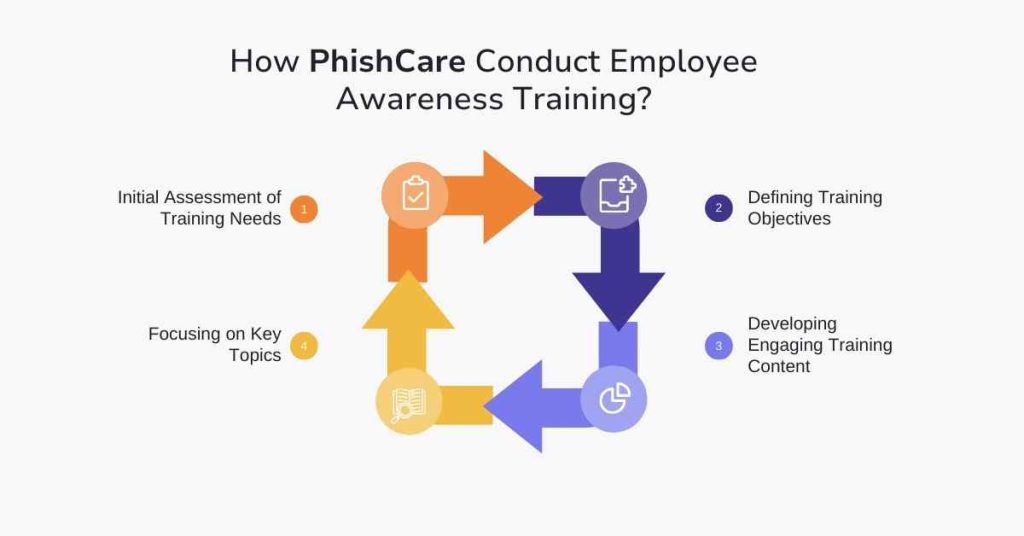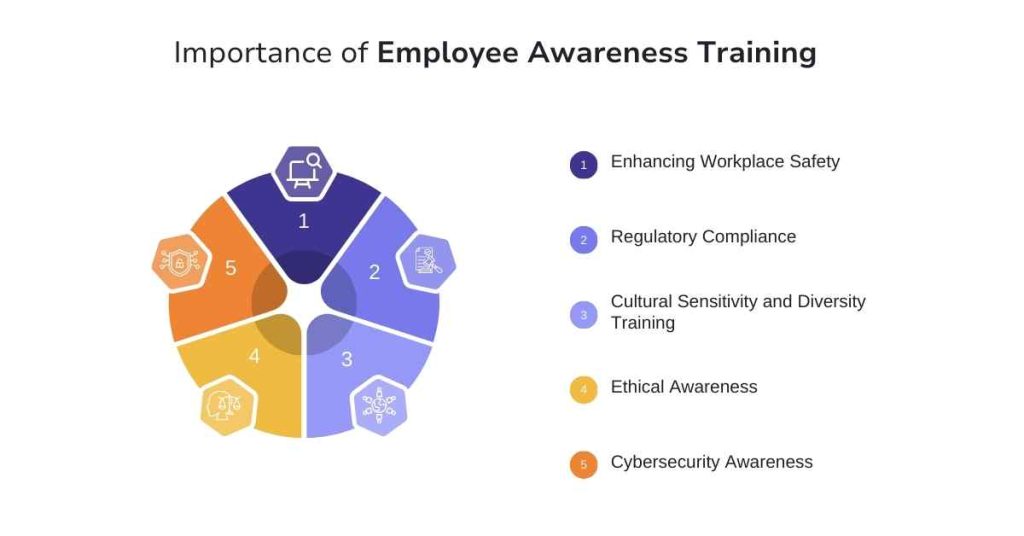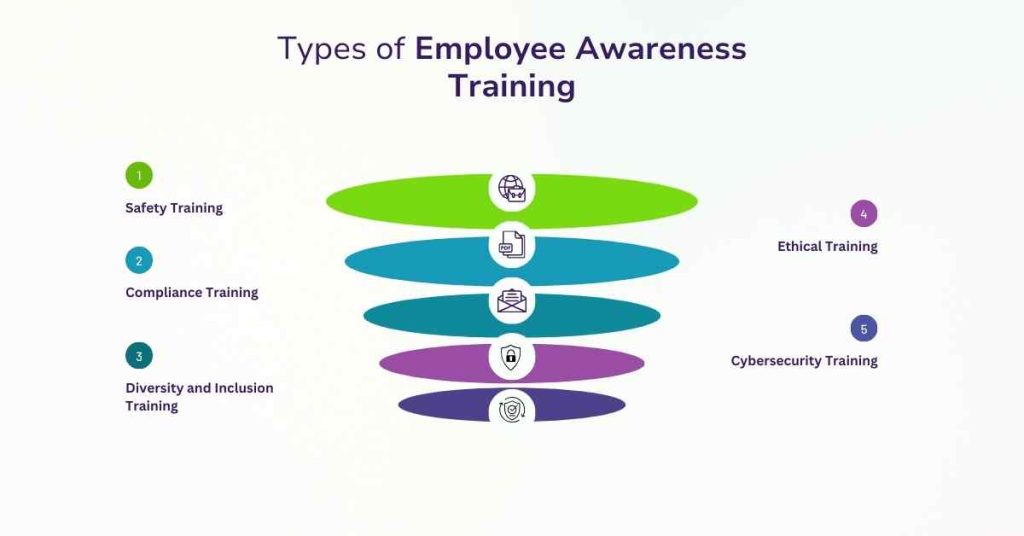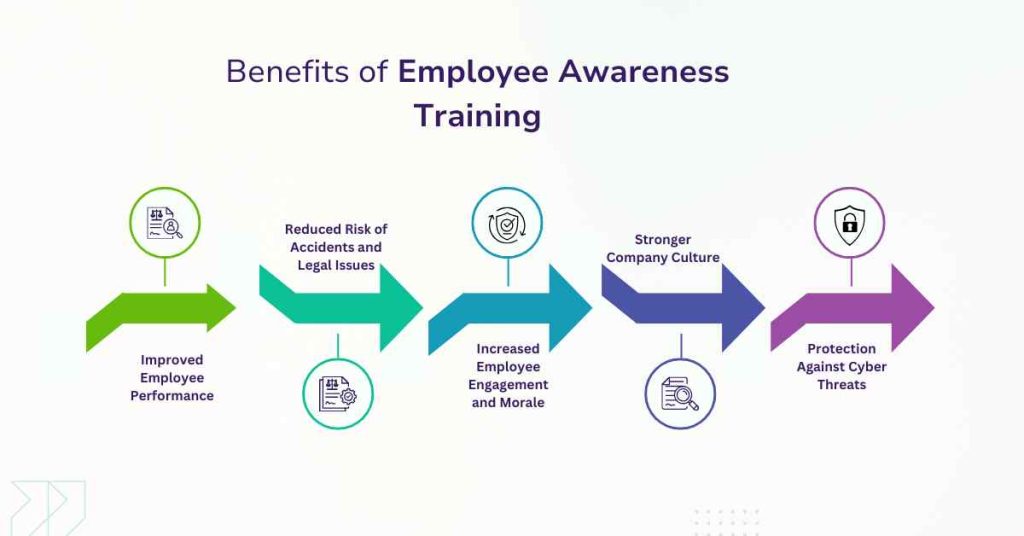Employee awareness training is a crucial aspect of organizational development that focuses on enhancing the knowledge and competency of employees regarding various topics that impact the workplace and their performance.
It encompasses various training programs designed to raise awareness about critical issues, including workplace safety, regulatory compliance, company policies, and cultural sensitivity. In this article, we will explore what is employee awareness training, significance, types, benefits, and best practices related to employee awareness training.
How Does PhishCare Conduct Employee Awareness Training?

PhishCare, known for its robust approach to cybersecurity education and training, employs a comprehensive strategy to conduct employee awareness training.
The goal is to empower employees with the knowledge and skills necessary to protect sensitive information and comply with best practices in cybersecurity. Here’s how CyberSapiens typically conducts its employee awareness training:
1. Initial Assessment of Training Needs
PhishCare begins by assessing the specific cybersecurity knowledge and skill levels of its employees. This may involve:
- Surveys and Questionnaires: Gathering insights into employees’ current understanding of cybersecurity threats and practices.
- Risk Assessments: Identifying potential vulnerabilities within the organization which can guide the focus of the training program.
2. Defining Training Objectives
Based on the assessment results, PhishCare defines clear training objectives that align with organizational goals. This helps ensure that all employees understand:
- The importance of cybersecurity in their daily tasks.
- Specific skills they need to mitigate risks effectively.
- Compliance regulations relevant to their roles.
3. Developing Engaging Training Content
PhishCare creates engaging and interactive training content tailored to diverse employee roles.. Training content typically includes:
- E-Learning Modules: Online courses featuring multimedia content, quizzes, and interactive scenarios that make learning more engaging.
- Workshops and Seminars: In-person or virtual sessions that allow for live demonstrations, discussions, and Q&A segments.
- Simulations: Practical exercises simulating real-world cyber threats (e.g., phishing attacks) to help employees recognize and respond appropriately.
Why PhishCare is the Best Phishing Simulation Tool for Employee awareness training!

- Customizable Templates
- Awareness Module
- Assessment Test
- Comprehensive Tracking
- Graphical Dashboard Access
- Campaign Report
- Custom Domain Integration
4. Focusing on Key Topics
The training covers several critical areas of cybersecurity, such as:
- Phishing Awareness: Recognizing and responding to phishing emails and messages.
- Password Management: Best practices for creating and managing strong passwords.
- Data Privacy Compliance: Understanding regulations like GDPR, HIPAA, and data handling procedures.
Importance of Employee Awareness Training

1. Enhancing Workplace Safety
One of the primary aims of employee awareness training is to promote workplace safety. By educating employees about potential hazards, emergency procedures, and safe work practices, organizations can significantly reduce the risk of accidents and injuries. A well-informed workforce is better equipped to recognize and respond to dangerous situations, fostering a safer work environment overall.
2. Regulatory Compliance
Many industries are governed by strict regulations that require organizations to provide training to employees. This training ensures that employees are aware of the laws and regulations relevant to their roles. For example, employees in healthcare must understand regulations like HIPAA in the United States, which protects patient privacy, while those in finance need to be aware of compliance issues like GDPR. Training helps organizations avoid legal repercussions and penalties.
3. Cultural Sensitivity and Diversity Training
As workplaces become increasingly diverse, employee awareness training related to cultural sensitivity and diversity is vital. This training promotes respect and understanding among employees from varied backgrounds, helping to create an inclusive work environment. Understanding cultural differences can lead to better teamwork, increased morale, and enhanced productivity.
4. Ethical Awareness
Ethics training is essential in fostering a culture of integrity within the organization. Employees need to be aware of the ethical standards expected of them, including issues like harassment, discrimination, and conflict of interest. By providing awareness training on these topics, organizations can prevent misconduct and establish a positive workplace culture.
5. Cybersecurity Awareness
Cybersecurity is a pressing concern for organizations. Employee awareness training regarding cybersecurity protocols is crucial in preventing data breaches and protecting sensitive information. Employees must be educated on recognizing phishing attempts, securely handling confidential data, and understanding the importance of strong passwords and cybersecurity measures.
Types of Employee Awareness Training

Employee awareness training can be categorized into several key types, depending on the specific needs of the organization:
1. Safety Training
Safety training focuses on educating employees about potential hazards in their work environment, emergency procedures, and best practices for maintaining safety. It may include fire safety training, first aid training, and specific knowledge related to the machinery or equipment used in the workplace.
2. Compliance Training
This type of training ensures that employees understand and adhere to various laws, regulations, and company policies. Compliance training often covers topics such as anti-discrimination policies, sexual harassment prevention, and industry-specific regulations.
3. Diversity and Inclusion Training
Diversity training aims to educate employees on the importance of diversity in the workplace. It addresses issues such as unconscious bias, cultural competency, and fostering an inclusive environment that values different perspectives.
4. Ethical Training
Ethical training focuses on guiding employees to make ethical decisions and understand their roles in preserving the company’s integrity. This may include training on whistleblower policies, reporting misconduct, and understanding conflicts of interest.
5. Cybersecurity Training
Cybersecurity training educates employees about potential cyber threats, safe internet practices, and the company’s cybersecurity policies. It is critical in protecting sensitive data and reducing the risk of cyber attacks.
Benefits of Employee Awareness Training

Investing in employee awareness training yields numerous benefits for organizations, including:
1. Improved Employee Performance
When employees are well-informed and understand their roles and responsibilities, they are more likely to perform effectively. Training enhances their skills and knowledge, leading to improved productivity and job satisfaction.
2. Reduced Risk of Accidents and Legal Issues
Awareness training fosters a culture of safety and compliance, which can significantly reduce the likelihood of accidents and legal problems. Organizations that prioritize safety and compliance are less likely to face fines, lawsuits, or reputational damage.
3. Increased Employee Engagement and Morale
Effective training programs enhance employee engagement by demonstrating that the organization values their growth and development. When employees feel supported and equipped with the knowledge they need, they are more likely to be satisfied in their roles and contribute positively to the workplace culture.
4. Stronger Company Culture
Employee awareness training contributes to building a strong organizational culture. When employees understand company values and expectations, they are more likely to embody those values in their daily interactions. This leads to a positive work environment where employees are aligned with the organization’s goals.
5. Protection Against Cyber Threats
Regular cybersecurity awareness training reduces the likelihood of data breaches and cyber attacks. By educating employees about potential threats and safe practices, organizations create a more secure digital environment.
Best Practices for Implementing Employee Awareness Training
To ensure the effectiveness of employee awareness training, organizations should consider the following best practices:
1. Assess Training Needs
Before implementing training programs, organizations should assess their specific needs and identify the gaps in employees’ knowledge. This can be done through surveys, interviews, or focus groups to gather insights directly from employees.
2. Tailor Training Programs
Training programs should be tailored to address the unique challenges and requirements of the organization and its employees. One-size-fits-all training may not resonate with all employees, so customizing content for different departments or roles can enhance engagement.
3. Use Engaging Training Methods
Utilizing a variety of training methods, such as interactive workshops, e-learning modules, videos, and simulations, can make the training process more engaging. Incorporating real-life examples and case studies can also help employees relate the training to their work.
4. Encourage Participation
Encourage employees to participate actively in training sessions by fostering an open environment for discussion and questions. Participation enhances retention and ensures that employees feel comfortable speaking up about their concerns.
5. Monitor and Evaluate Training Effectiveness
Organizations should regularly monitor and evaluate the effectiveness of their training programs. This can involve collecting feedback from participants, assessing changes in workplace behavior, and analyzing performance metrics. Continuous improvement based on feedback ensures that training remains relevant and impactful.
6. Make Training Ongoing
Employee awareness training should not be a one-time event. Regular refresher courses and updates on policy changes, especially related to compliance and cybersecurity, are essential to ensure that employees remain informed.
Conclusion
Employee awareness training is a vital component of organizational success. It not only enhances workplace safety, improves employee performance, and ensures compliance with regulations, but it also fosters a positive organizational culture. By implementing effective training programs tailored to the needs of employees, organizations can empower their workforce, mitigate risks, and position themselves for long-term success. Investing in employee awareness training is not just a legal obligation; it is an opportunity to cultivate a more knowledgeable, engaged, and resilient workforce.
FAQs: What is Employee Awareness Training?
1. Why is employee awareness training important?
This training is important as it improves workplace safety and ensures compliance with laws and regulations.
It also promotes a positive organizational culture while enhancing employee performance and engagement.
2. What topics are typically covered in employee awareness training?
Common topics include workplace safety, compliance with regulations, ethical decision-making, diversity and inclusion, cybersecurity, and company policies and procedures.
3. How often should employee awareness training be conducted?
The frequency of training should be determined by organizational needs, industry requirements, and changes in regulations, but it’s generally advisable to provide training at least annually, with refresher courses as needed.
4. What are the benefits of employee awareness training?
Benefits include improved employee performance, enhanced workplace safety, reduced legal risks, greater employee engagement, and a stronger organizational culture.
5. Who should conduct employee awareness training?
Training can be conducted by internal trainers, external experts, or professional training organizations, depending on the complexity of the topics and the resources available.
6. How can organizations assess their training needs?
Organizations can assess their training needs through employee surveys, focus groups, performance evaluations, and compliance audits to identify knowledge gaps and areas for improvement.
7. What methods are effective for delivering employee awareness training?
Effective methods include workshops, online training modules, interactive simulations, e-learning courses, and real-life case studies that engage employees and facilitate learning.
8. What should organizations do to ensure training effectiveness?
To ensure effectiveness, organizations should gather participant feedback, monitor behavioral changes in the workplace, evaluate performance metrics, and continually update the training content based on emerging trends and regulations.
9. Is employee awareness training mandatory?
While not all employee awareness training is legally mandated, many industries are required to provide specific training related to safety, compliance, and ethics. Organizations should prioritize training to ensure a knowledgeable and compliant workforce.








